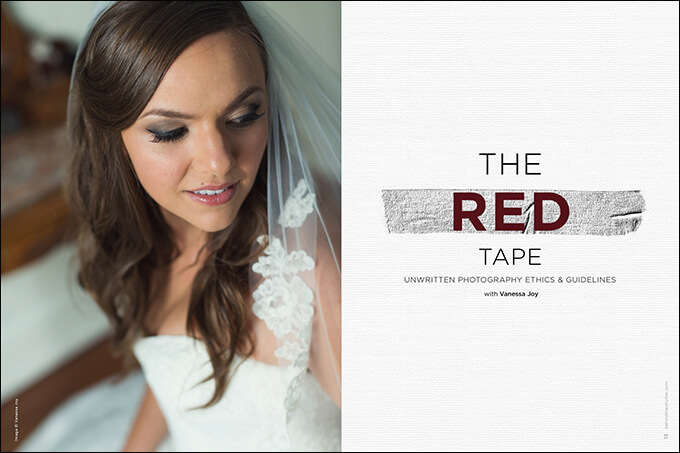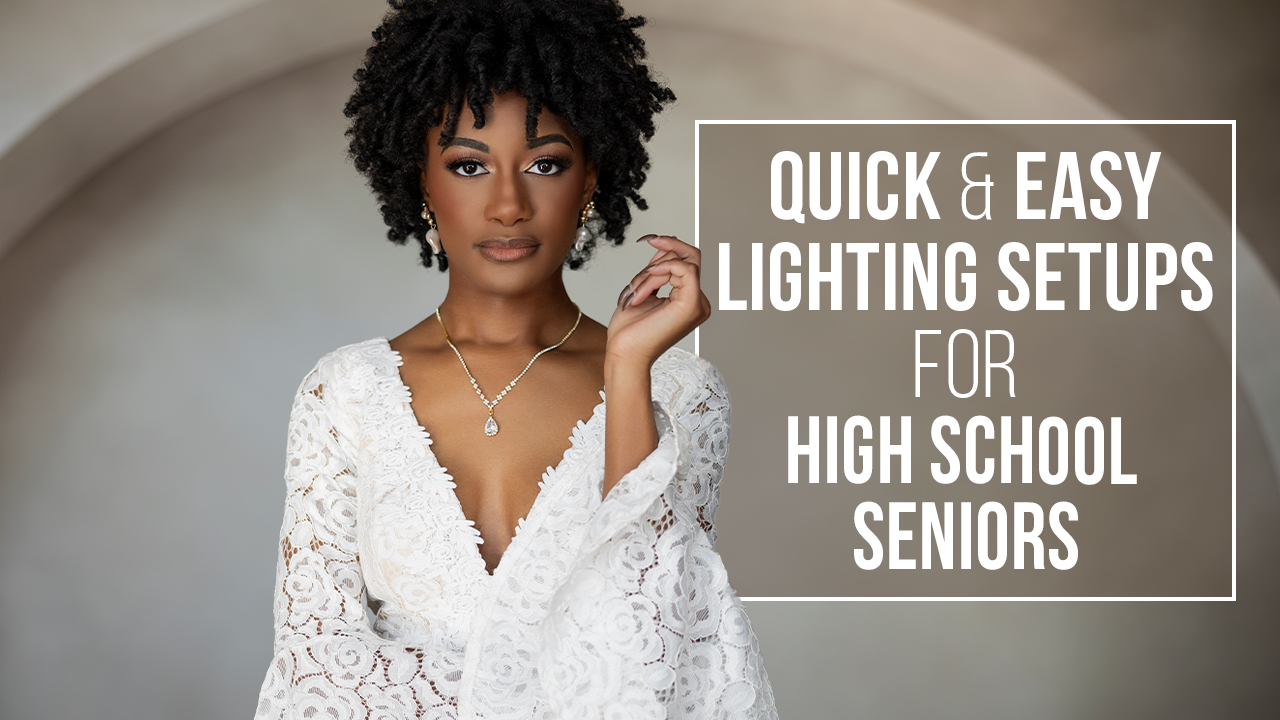The Red Tape: Unwritten Photography Ethics & Guidelines with Vanessa Joy
Want more information on this article? Get access to video content and additional supporting images. Launch the March issue of the magazine by logging in or signing up for a free account by clicking here. Shutter Magazine is the industry’s leading professional photography magazine.
This article deals with the unspoken rules that most beginning photographers follow only by accident. These rules, when broken, will easily get you blacklisted by your peers and colleagues.
First, let me assure you that if you’ve already made some of these mistakes, you’re not alone. I’ve made some doozies over the years. Sometimes I was trying to get away with it, other times I was completely ignorant and, truth be told, sometimes I was just asking for it.
Get involved in local and national photography groups. Behind the Shutter has a great online Facebook group, and provides opportunities to network in person at ShutterFest and Lunacy. Being in the online forums and groups gives you access to hundreds of photographers and keeps you in the know on hot topics in the photography world.
Examine how you work with your peers. In the community-driven industry and social media world, I can’t stress enough how essential it is that you maintain good relationships. You could be the best photographer in the world, but if no one likes working with you, your chances of have a successful business diminish greatly. I know you’re thinking, “But the client hires me, not them.” Trust me, you’ll be amazed at just how much other wedding vendor recommendations or condemnations can affect your bottom line.
Working for Other People
Every year I make it a point to be a second shooter on other photographers’ weddings. It helps improve my photography by seeing how others run a wedding. It gives me a chance to be more creative since I don’t have to worry about the staple wedding photos.
Let’s highlight the things you should know, and do, so your reputation as a second shooter and photographer does not become tarnished.
First, you need to communicate with the photographer you’re working with to determine what they allow you to do with the photos you take. There are 100 schools of thought on this. Some believe that if they’re paying you to take the pictures, you shouldn’t be able to use them at all. Others, like me, are okay with you using them, but not just anywhere you feel like it. Some will let you come shoot to build your portfolio but won’t pay you for the day.
Whatever the conditions are, make sure you’re clear on them with each photographer you work for so you don’t end up with an embarrassing and potentially reputation-ruining debacle in the end.
When I first started as a wedding photographer, I worked for another company. Back then, I had no clue that I was going to start my own business, nor did I have the faintest idea that there were rules about shooting for another company. Years later, when I went out on my own, I created my own website using pictures I had taken that I believed I could use. Boy, was I wrong.
When I was confronted about it, I was flabbergasted and stammered, “But I took them!” I couldn’t comprehend what photographers for years had known to be true, and what federal copyright states. If a freelance photographer is hired for a job, the images produced for that gig belong to the contracting company, period. Thankfully, after helping out the photographer I worked for with a website issue, he let me use the images. But it left a bad taste in both of our mouths, and certainly didn’t help keep the bridge between us intact.
Secondly, it’s not your wedding. If you want to get asked to second shoot again and build a good reputation within the photography industry in your area, remember this one. Don’t make yourself known to the clients or guests as anything other than the photographer working for XYZ Photography. Introduce yourself by your first name, and don’t hand out your personal business cards (but do hand out the primary’s business card). Don’t connect with the clients, vendors or bridal party on or after the wedding day.
Whenever you’re shooting a wedding for someone else, treat it like it’s your own. Do not call in sick. There are no sick days on wedding day. If there is an emergency, find a replacement for yourself before informing the main photographer that you won’t be able to go. They may or may not take your recommendation, but you’ll likely never get hired again if you abandon ship without at least throwing a life vest.
People Working for You
The first time you have someone work for you, it can be extremely nerve-wracking. You’ve hired someone else to represent you and your business—someone who, for certain portions of the day, you’ll have little to no control over. Hiring the right people is an art in itself.
Before you hire someone, research their work like you’re a bride. Don’t just look at their best 20 images of all time on their website. Ask to see a full wedding they’ve shot from start to finish. Find references for the photographer to make sure they’re hard-working and professional. Do they represent your brand and what you’re trying to portray on a wedding day?
Talk about expectations with your shooters. What should they wear? How should they act? Have a contract in place for a second shooter with all of your terms neatly written out. Even when working with friends, things can get sticky in business. It’s always best to protect yourself by having clearly laid out expectations for anyone you’re working with.
Give your second shooters and assistants general information about the wedding when you’re offering the job to them. Include the number of hours they’ll work and where the wedding is located, which may affect their decision on accepting the job. The last thing you want is to be stuck, like I was once, three days before a wedding with a second shooter deciding that they won’t be photographing the wedding because it was too far from their home. It was my fault for not telling the photographer that information beforehand. It was their fault for not even bothering to find a replacement on such short notice.
Send your second shooter a more detailed schedule closer to the wedding. It’s polite to send a final schedule at least three days before the wedding, if not a week. That schedule should include bride and groom names, start/end/ceremony/reception times, and all location addresses for the day.
Follow the golden rule with those who are working for you. Do unto others as you’d have done unto you. Treat people right, be understanding, forgive mistakes and always, always think like a CEO.
Rules You Didn’t Know Existed
The following are just some tidbits, some fun and some not so fun, that no one tells you when you’re following your dream of becoming a wedding photographer.
- Some reception venues forbid you to eat cocktail-hour food. Others will get it for you.
- Most reception venues won’t feed you unless the bride and groom pay for it. Some forget to do so even if it was paid for.
- There’s no guarantee that you’ll be fed anything at all. Pack protein bars and water.
- Typically you get fed last at weddings; sometimes you’re fed in the kitchen.
- Some reception venues send you forms and contracts directing you how to dress, behave and even where you’re allowed to use the bathroom.
- A lot of reception venues ask for proof of insurance, typically $1 million in coverage, and some ask to be listed as additionally insured.
- The officiant at a wedding may restrict where you can take pictures and how (flash or no flash) during the ceremony.
- It’s not professional to drink alcohol at a wedding, even when the bride and groom insist on it. It’s often forbidden by the reception venue as well.
- Publically or even privately bashing other photographers or wedding vendors will come back to haunt you.
- Earplugs come in handy during the reception.
Now that you know, you can’t play dumb. Ignorance isn’t bliss when it comes to these guidelines, so use your new knowledge wisely and do your best to play by the rules.
Want more information on this article? Get access to video content and additional supporting images. Launch the March issue of the magazine by logging in or signing up for a free account by clicking here. Shutter Magazine is the industry’s leading professional photography magazine.




